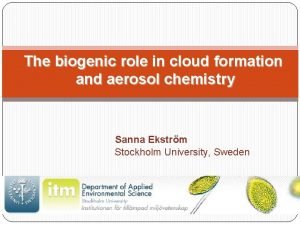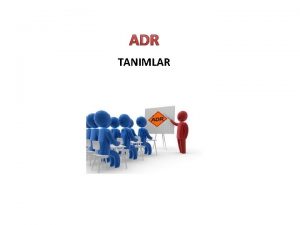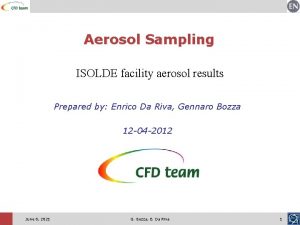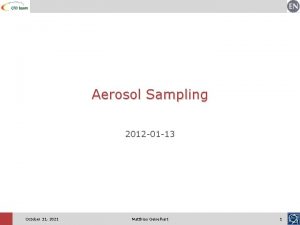Aerosol Sampling 2011 11 11 June 19 2021








- Slides: 8

Aerosol Sampling 2011 -11 -11 June 19, 2021 Matthias Geiselhart 1

Straight stretch model • Solutions at the outlet for – – – • are intended to be used as initial inlet conditions for further simulations. Simple geometry model to investigate particle loss mechanisms caused by – – – • velocity distribution turbulence kinetic energy k specific turbulent dissipation rate ω turbulence dispersion gravity length Mesh: – – – 2 M cells 16 Prism Layers 22. 75 mm of total Prism Layer Thickness June 19, 2021 Matthias Geiselhart 2

Particle loss - illustrated • uniform velocity 0. 1 µm – Negligible loss by gravitational force on particles smaller than about 0. 5 µm, [1]. – Gravitational force cause most particle loss (dark blue points all over 10 m). – – Independent on particle size, achieving balanced particle distribution at the inlet causes loss. Turbulent inertial deposition loss due to the curved streamlines (eddies) occurs relatively small. 1. 0 µm 10. 0 µm • fully developed flow 0. 1 µm 1. 0 µm 10. 0 µm – Gravitational force cause most particle loss (dark blue points all over 10 m). – Despite the fully developed flow, achieving balanced particle distribution at the inlet causes loss again. y: flow direction Legend: point indicates location, where one particle got stuck to the wall. June 19, 2021 Matthias Geiselhart 3

Particle loss - quantitative Number of Particles /- uniform velocity length /mm June 19, 2021 Matthias Geiselhart 4

Particle loss - quantitative Number of Particles /- uniform velocity length /mm June 19, 2021 Matthias Geiselhart 5

Particle loss - randomness Initial conditions • • • Path Ø 1 μm particle 1 paricle injected Injection point in centroid of inlet Successive steps • • reference run reload simulation restart Star-CCM+ reboot PC Result • • nonappearance of randomness all 8 runs reproduce same result (path) June 19, 2021 Matthias Geiselhart 6

Particle loss - quantitative uniform velocity 5031 5032 5033 5034 5035 5036 5037 5038 5039 5040 - 23480 23480 23480 - 1 μm 5001 5002 5003 5004 5005 5006 0. 1 μm 5001 5002 1892 1892 1892 - 23480 23480 - 11300 11300 June 19, 2021 12180 12180 ηgrav calc / ηgrav sim 58. 0% 58. 0% - 48. 1% - 2319 4505 ηgrav calc 8. 1% 8. 1% - - 21161 22480 ηgrav sim 21588 21588 21588 - - 23480 26985 No. of lost Particles No. of Particles (10 m) No. of Particles (0 m) No. of Sim. 10 μm • 7. 20 7. 20 - 99. 5% - 90. 1% 100. 0% 83. 3% 100. 0% 2. 07 - 1. 11 1. 20 Matthias Geiselhart 7

Particle loss - quantitative fully developed flow 39991 39992 40009 40010 40011 40012 40013 40014 40015 40016 40017 40018 23480 23480 23480 1948 1950 1950 1950 21532 21530 21530 21530 8. 3% 8. 3% 58. 0% 58. 0% 6. 99 6. 98 6. 98 1 μm 39993 39992 39993 39994 39995 39996 39997 39998 39999 40000 40001 23480 23480 23480 12173 12150 12150 12150 11307 11330 11330 11330 51. 8% 51. 7% 51. 7% 99. 5% 99. 5% 1. 92 1. 92 0. 1 μm 39989 39990 23480 23218 262 98. 9% 100. 0% 1. 01 June 19, 2021 • The bigger the particle diameter, the less match between ηgrav calc and ηgrav sim • Slight difference between uniform velocity and fully developed flow: ηgrav sim (uv)< ηgrav sim (fdf) • Variation in ηgrav sim and number of lost particles (grey highlighted) by: ηgrav calc / ηgrav sim ηgrav calc ηgrav sim No. of lost Particles No. of Particles (10 m) No. of Particles (0 m) No. of Sim. 10 μm – – – Matthias Geiselhart No changes in initial conditions Change in displaying features Results match with each other • Sufficient amount of particles 8















